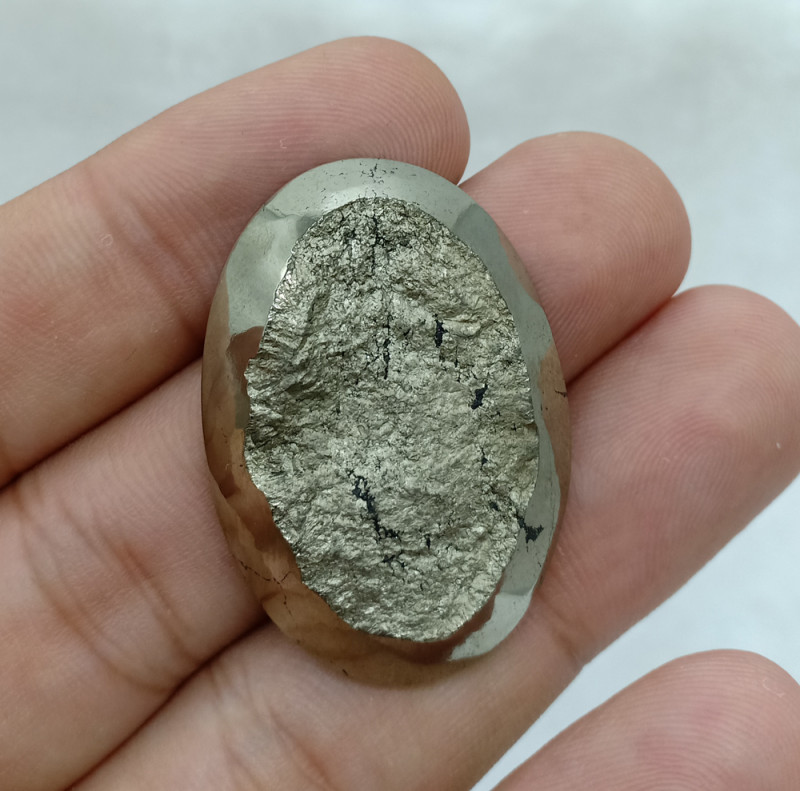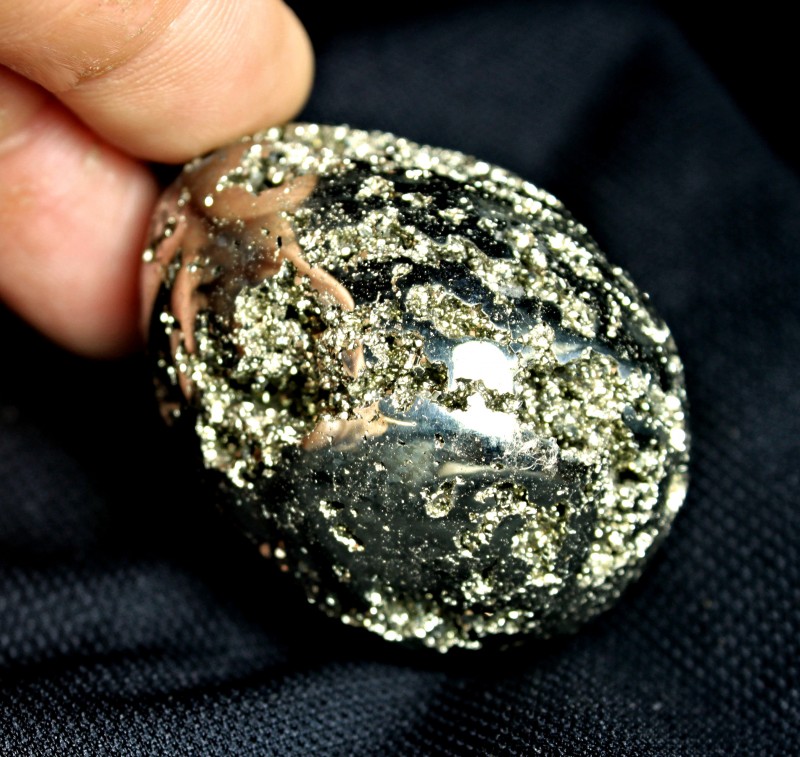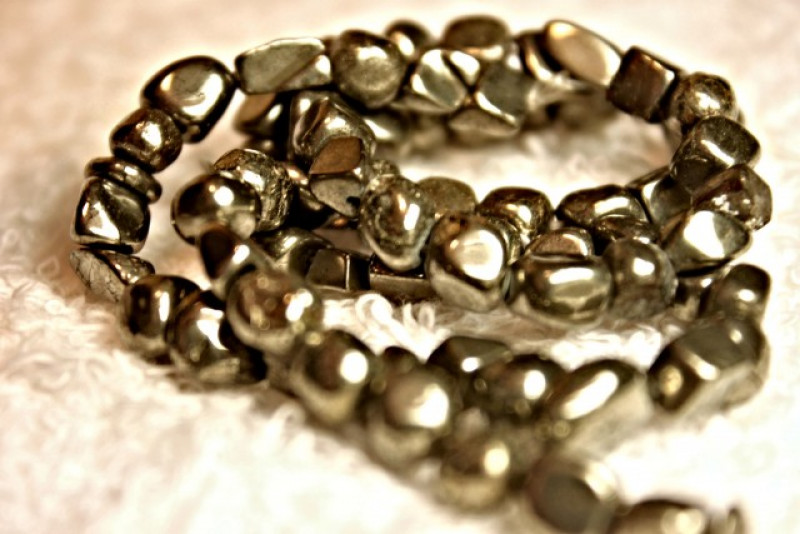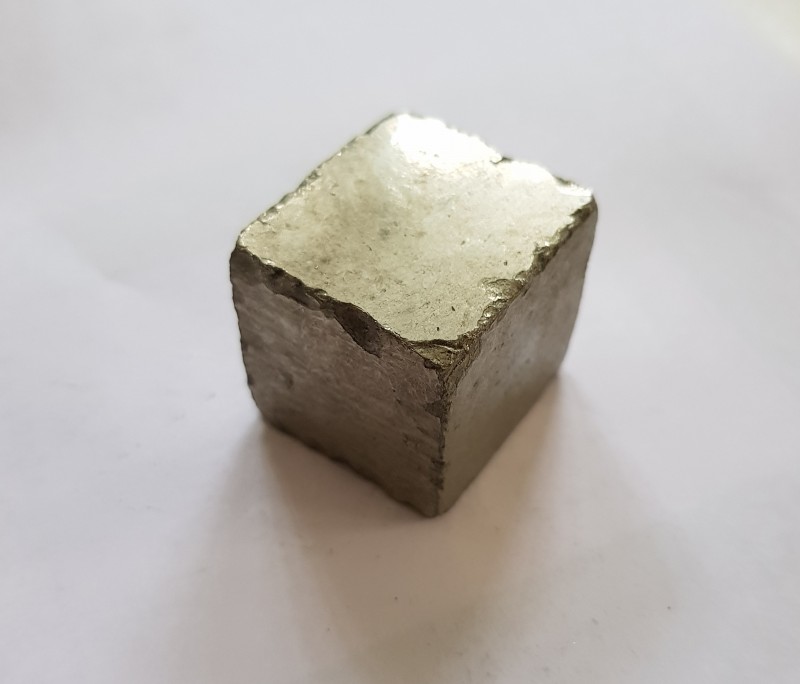
Pyriet edelsteen: betekenissen, helende eigenschappen, toepassingen en meer!
 Pyriet edelstenen zijn lichtgele, koperachtige ijzersulfide edelstenen met een metaalachtige glans. De kleur en glans lijken op goud, wat ze de bijnaam "gekkengoud" opleverde.
Pyriet edelstenen zijn lichtgele, koperachtige ijzersulfide edelstenen met een metaalachtige glans. De kleur en glans lijken op goud, wat ze de bijnaam "gekkengoud" opleverde.
Is pyriet een edelsteen? Nee, pyriet is een halfedelsteen . Is pyriet een zeldzaam mineraal? Nee, pyriet is er in overvloed! Sterker nog, de steen is wereldwijd de meest voorkomende sulfide.
Als het geen zeldzaam goud of kostbare edelsteen is, wat is er dan zo bijzonder aan pyriet? Heel veel! Ondanks de bijnaam "gekkengoud", biedt pyriet veel waarde als spiritueel, industrieel en sieradenmateriaal!
Vandaag leert u alles wat deze edelsteen zo krachtig maakt, van de kristalbetekenis en toepassingen van pyriet tot zijn eigenschappen en prijs!

Over pyrietsteen
Pyriet wordt ook wel ijzerpyriet of gewoon ijzerdisulfide genoemd. De metaalkleur van de steen kan variëren van licht messing tot meer verzadigde goudtinten. Eén pyrietsoort kan in elke kleur schitteren: regenboogpyriet!
Regenboogpyriet, of iriserend pyriet, is een soort pyriet-druzy. " Druzy " verwijst naar edelstenen die een steen bedekken met kleine, glinsterende kristalclusters of korstjes.
Pyriet is geen geboortesteen, maar wel een astrologische steen! De gouden edelsteen is een sterrenbeeldsteen voor Leeuw, en een sterrenbeeldsteen voor de zon en Mercurius.
Pyriet specificaties en kenmerken
Pyriet behoort tot de mineraalgroep pyriet, maar valt ook onder de sulfidenclassificatie. Het enige mineraal dat overeenkomt met de eigenschappen van pyriet is markasiet , een licht zilvergele steen met groene ondertonen. Markasiet heeft dezelfde chemische samenstelling als pyriet, maar een andere kristalstructuur.
Welke mineralen zitten er in pyriet? Nou, pyriet wordt meestal gevonden in andere mineralen zoals Colombiaanse smaragd , lapis lazuli en Ceylon saffier , om er maar een paar te noemen. Wat betreft de elementen kan pyriet echter nikkel, kobalt, koper, lood, arseen en zelfs goud bevatten!
Is pyriet magnetisch met zoveel metalen erin? Niet helemaal. Pyriet is paramagnetisch, wat betekent dat het tijdelijk een zwak magnetisme vertoont rond een aangelegd magnetisch veld. Een vergelijkbaar mineraal, pyrrhotiet, wordt vaak "magnetisch pyriet" genoemd, hoewel het magnetisme zwak is.
Hieronder vindt u de overige mineraalgegevens van pyriet!
Kleur : Messinggeel tot dof messing of zilver; heeft soms iriserende aanslag
Mohs-hardheid : 6-6,5
Kristalstructuur : Isometrisch
Glans : Metaalachtig
Transparantie : Ondoorzichtig
Brekingsindex : 1,73-1,83
Dichtheid : 4,8-5,2
Splijting : slecht/onduidelijk op [001] en [110]
Fractuur : Onregelmatig/Ongelijkmatig, soms conchoïdaal
Streep : Groenachtig zwart tot bruinachtig zwart
Voordat we dieper ingaan op de spirituele eigenschappen van pyriet, bespreken we wat ‘fool’s gold’ onderscheidt van echt goud.

Pyriet versus goud
Allereerst is het belangrijk om te weten dat pyriet goud kan bevatten. Deze exemplaren, ook wel goudhoudend pyriet genoemd, kunnen meer dan 0,25 procent goud bevatten.
Pyriet en goud hebben een vergelijkbare kleur en glans, en een vergelijkbare structuur. De belangrijkste onderscheidende kenmerken zijn textuur, kleur, hardheid en dichtheid.
Textuur : Ruwe pyrietsteen heeft scherpe kristallen, terwijl de randen van ruw goud gladder en ronder zijn.
Kleur : Echt goud heeft een heldere, geelgouden kleur, terwijl pyriet een meer koperachtige toon heeft, soms met zilveren ondertonen.
Streep : De pyrietstreep is groenachtig of bruinzwart, maar goud heeft een goudgele streep.
Hardheid : De hardheid van pyriet (6-6,5) is veel harder dan de hardheid van goud (2,5). Zelfs een vingernagel kan goud krassen.
Dichtheid : Pyriet voelt veel lichter aan dan goud. De dichtheid van pyriet is 4,8-5, terwijl de dichtheid van goud 1,5 keer hoger is!
Een andere identificatiemethode is smelten. Echt goud smelt, maar pyriet smelt niet, maar ontbindt alleen. Bovendien kan zuiver pyriet worden gebruikt voor sieraden, terwijl puur goud met andere metalen moet worden gemengd om draagbare stukken te maken.
Nu u een goed begrip heeft van de mineralenkant, wat is de betekenis van de pyriet edelsteen?

Betekenis en geschiedenis van pyriet
Pyriet is al sinds de prehistorie van belang! Archeologisch bewijs van pyriet in prehistorische grafheuvels heeft wetenschappers doen vermoeden dat zelfs holbewoners de steen gebruikten.
De oude Inca's beschouwden de betekenis van de pyriet-edelsteen als een hulpmiddel voor magie en meditatie, terwijl de indianen gepolijste exemplaren als spiegels gebruikten. Elders, zoals in oude Sumerische teksten en middeleeuwse poëzie, vertegenwoordigde de steen dingen die 'overgewaardeerd' werden.
Als het een symbool van overschatte zaken was, brengt pyriet dan nog steeds geluk? Absoluut! Sterker nog, sommige bijnamen voor pyriet zijn onder andere "Steen van Rijkdom" en "Steen van Geluk".
De symbolische betekenis van pyriet is geestelijke kracht, overvloed en verbeeldingskracht.
Geschiedenis van pyriet
De naam pyriet komt van het Griekse woord pyrietlithos , wat 'vuurslaande steen' betekent. Oude volkeren sloegen pyriet met een ander mineraal, zoals vuursteen, waardoor vonken ontstonden die vuur veroorzaakten.
Waar komt de bijnaam "fool's gold" vandaan? Het bekendste voorbeeld was de "Gold Rush" van 1849, toen zwermen Amerikanen naar Californië trokken om goud te zoeken. Mijnwerkers verwarden in die tijd vaak pyriet met goud, maar deze "dwaze" vergissing gaat nog veel verder terug.
De Engelse kaper Martin Frobisher kreeg in 1577 koninklijke steun om een "glinsterende zwarte steen" uit Canada mee te nemen. Hij verscheepte er zo'n 1600 ton van, maar het bleek gewone steen met pyrietglitters te zijn.
In 1608 kocht John Smith – jawel, die van Pocahontas – zo'n 1100 ton zand van lokale indianenstammen in opdracht van zijn kapitein, Christopher Newport. Newport was ervan overtuigd dat het zand goud bevatte en nam het mee terug naar Engeland, maar ontdekte dat het pyrietsediment was.
Ondanks de vele teleurstellende voorbeelden was pyriet cruciaal in de menselijke geschiedenis. Het ontstak buskruit in radslotgeweren, leverde zwavel en ijzer en stichtte branden.
Pyriet werd halverwege de 19e eeuw populair als juweel in de VS en Europa, hoewel het vaak ten onrechte als markasiet werd bestempeld.
We kennen de historische toepassingen, maar waar is kristalpyriet vandaag de dag nog steeds goed voor?

De helende eigenschappen van pyriet
De kleuren en energieën van edelstenen maken ze bruikbaar als helende stenen . Goud is de kleur van warmte, rijkdom en prestige, en net als andere gele en gouden edelstenen kan pyriet vreugde en focus versterken.
Waarvoor wordt pyriet gebruikt voor specifieke genezing?
Lichamelijke genezing
Kristalgenezers gebruiken pyriet ter bescherming tegen milieuverontreinigende stoffen (zoals elektromagnetische velden van computers) en voor de behandeling van longproblemen.
Andere vermeende fysieke voordelen van pyriet edelstenen zijn onder meer het versterken van botten, geheugen en celvorming.
Emotionele genezing
Als het lijkt alsof negativiteit je altijd achtervolgt, kan pyriet je beschermen tegen negatieve energieën. Het verheldert bovendien de waarheid, zodat je die angstige gedachten vaarwel kunt zeggen.
Pyrietkristal wordt ook wel de ‘Steen van de Welvaart’ genoemd vanwege de vermeende eigenschappen die het zou hebben om overvloed aan te trekken en het zelfvertrouwen te vergroten.
Spirituele genezing
Pyriet is een krachtig kristal in Feng Shui. Beoefenaars raden pyriet aan om je financiën te verbeteren en mannelijke en vrouwelijke krachten in balans te brengen.
Waar plaats ik pyriet? De beste Feng Shui-gebieden voor pyriet zijn:
Xun-gebied : Plaats dit in de linkerhoek van een kamer om rijkdom en overvloed aan te trekken,
Qian-gebied : Plaats dit in de rechterhoek, het dichtst bij u in de kamer, om welwillende mensen in uw leven aan te trekken.
Voor welk chakra is pyriet geschikt?
Chakra healing houdt in dat je je chakra's (zeven energiecentra) in balans brengt om de symptomen van een blokkade aan te pakken. Pyrietkristalchakra healing is het meest geschikt voor het zonnevlechtchakra.
Je weet dat je zonnevlechtchakra geblokkeerd is als je je onzeker of afgesloten voelt van de wereld en jezelf. Door pyriet als chakrasteen te gebruiken, kun je alle gevoelens van een open zonnevlechtchakra oproepen: motivatie, doelgerichtheid en zelfvertrouwen.
Wilt u zeker zijn van uw aankoop ? Lees dan hieronder op welke waardefactoren u moet letten!

Eigenschappen van pyriet edelstenen
Edelsteeneigenschappen, of waardefactoren, helpen experts de objectieve waarde van een edelsteen te bepalen. De waarde van pyriet wordt bepaald door de kleur en de slijpvorm.
Kleur
De kleur van pyriet kan variëren, maar rijkere goudtinten zijn waardevoller. Regenboogpyriet vertoont talloze kleuren in zijn irisatie, maar de meest waardevolle exemplaren vertonen alle kleuren van de regenboog.
Snee
Geslepen pyriet, met of zonder facetten, is doorgaans waardevoller dan een ruwe pyrietsteen, omdat de broosheid van de steen en de hittegevoeligheid vakmanschap vereisen.
Veelvoorkomende facetslijpvormen voor pyriet zijn onder andere rond, peervormig en schaakbordvormig. Juweliers kunnen deze facetslijpstenen afzonderlijk gebruiken, bijvoorbeeld in een pyrietketting, of ze combineren met ongefacetteerde slijpvormen om facetkralen of facetcabochons te maken.
Een andere veelgebruikte methode is de roosslijpvorm, waarbij de basis van de steen vlak en ongefacetteerd is, maar de bovenkant een koepelvorm heeft met driehoekige facetten. Populaire ongefacetteerde slijpvormen voor pyriet zijn onder andere cabochons, houtsnijwerk en kralen .
Ruwe pyriet heeft enige waarde, omdat de steen vele prachtige vormen kan aannemen. Zo is een Spaanse pyrietkubus, die een matrix vormt met zijn moedergesteente, gewild bij verzamelaars. Een andere ruwe soort is kathedraalpyriet, waarbij de steen gotische markeringen heeft.
Helderheid
Pyriet is een ondoorzichtige steen die vaak een insluitsel vormt in andere stenen, waaronder:
Aventurijn
Bloedsteen
Beryl (Smaragd, Aquamarijn)
Chrysoberyl
Veldspaat (zonnesteen, oligoklaas, labradoriet)
Granaat (Hessoniet)
Lapis Lazuli
Saffier
Sodaliet
Sfaleriet
Toermalijn (Draviet)
Turkoois
Voordat pyriet überhaupt bij de juwelier terechtkomt, moet het eerst worden gevormd. Hoe ontstaat het en waar wordt pyriet gevonden?

Oorsprong en bronnen van pyriet
Pyriet komt voor in verschillende vormen, gesteenten en omstandigheden. Enkele veelvoorkomende omgevingen zijn hydrothermale aders, sedimentaire afzettingen, gescheiden magmaconcentraties en metamorfe gesteenten.
In sedimentaire afzettingen vormt pyriet zich waar weinig zuurstof is, maar wel ijzer en zwavel. Vaak bevatten deze omgevingen (zoals steenkool en donkere schalie) organisch materiaal dat vergaat, zuurstof opneemt en zwavel afgeeft.
Pyrietvormen omvatten kubussen, pyritoëders en penetratie-twinning (meerdere vergroeide kristallen). Pyriet- (of marcasiet-)kristallen die een platte schijf van uitstralende kristallen vormen, worden een "pyrietdollar" of "pyrietzon" genoemd.
Waar wordt het mineraal pyriet gevonden?
Mijnbouwlocaties
Regenboogpyriet komt alleen uit Rusland, maar er zijn wereldwijd duizenden pyrietvindplaatsen. Enkele prominente bronnen staan bekend om hun specifieke pyriet, zoals:
Italië : Hoogwaardige pyritohedrale pyriet
Peru : Enorme afzettingen van pyrietkristalclusters
Spanje : Beroemd om zijn perfecte, grote kristallen en perfecte pyrietblokjes, vaak ingebed in een bruine matrix
Tanzania : onlangs ontdekte afzetting met complexe, uniek gevormde kristallen
VS : Grote pyritohedrons en kubussen uit Utah; Grote vergroeide kubussen uit Colorado; Pyrietdollars (zonnen) uit Illinois; Octaëdrische kristallen uit Pennsylvania; Enorme ronde, buisvormige pyrietgroei uit Ohio
Laten we nu eens kijken wat je kunt verwachten van de prijs van pyriet.

Pyriet edelsteen prijs en waarde
Gelukkig is pyriet betaalbaar! De duurste pyriet is een gefacetteerde pyriet edelsteen , doorgaans $ 5-$ 8 per karaat. Daarna komen pyriet cabochons, voor ongeveer $ 1 per karaat.
Ruwe pyriet kost tussen de $ 0,03 en $ 0,05 per karaat, terwijl monsters $ 0,30 tot $ 0,65 per karaat kosten. Als u op zoek bent naar "fool's gold" nuggets, kunt u zakken van 453 gram vinden voor $ 10.
Als je echt goud in een pyriet vindt, zal de prijs veel hoger liggen. Goudhoudende pyriet bevat meestal ongeveer 0,25 procent goud per gewicht, dus laten we zeggen dat goud momenteel $ 1.500 per troy ounce (1 troy ounce = 31,1 gram) kost. Een ton van die goudhoudende pyriet bevat ongeveer 73 troy ounce goud, met een waarde van meer dan $ 100.000!
Als u echter van plan bent het goud dat zich in een pyriet bevindt te verkopen, hangt de waarde ook af van hoe goed het goud eruit gehaald kan worden en hoe kostbaar dat proces is.
Ongeacht de prijs, de waarde van pyriet gaat verder dan geld. Een deel van de waarde ervan hangt af van hoe goed je voor je pyriet zorgt!

Pyrietverzorging en -onderhoud
Voor regelmatige reiniging wast u de steen in lauw zeepsop en spoelt u hem vervolgens af. Om oxidatie te voorkomen, droogt u de steen en de zetting grondig af met een zachte doek.
Om aanslag van pyriet te verwijderen, kunt u een roestvlekkenoplossing gebruiken of de steen 5 minuten laten weken in een 2:1-oplossing van gedestilleerd water en azijn. Spoel de steen na beide methoden af met schoon water en droog hem grondig af.
Pyriet bewaart u het beste in een droge omgeving, bijvoorbeeld in een afgesloten plastic container. Bewaar de container niet in de buurt van andere edelstenen en carbonaatmineralen zoals calciet (de zure dampen daarvan kunnen schadelijk zijn voor uw pyriet).
Vind goud met pyriet!
Ze zeggen dat het niet alles goud is wat blinkt, maar pyriet is nog steeds een glinsterende schat!
Het staat misschien bekend als "fool's gold", maar de voordelen van pyriet zijn niet te versmaden. Met betaalbare prijzen, unieke vormen en het vermogen om rijkdom aan te trekken, wat is er niet geweldig aan pyriet?
Wil je er fantastisch uitzien en je fantastisch voelen? Koop vandaag nog pyriet edelstenen!
Zoek de Gemstone Encyclopedia
Gerelateerde veilingen
gerelateerde artikelen
Azotische behandeling van topaas en kwarts is een behandeling waarbij een kleurlaag over een edelsteen wordt aangebracht. Lees meer over deze behandeling en bekijk onze stenen in de aanbieding.
8th May 2018
Er zijn veel behandelingen voor parels die hun uiterlijk veranderen. De meeste van deze behandelingen zijn acceptabel. Lees meer over deze edelsteen en bekijk de prachtig geslepen stenen die we te koop aanbieden.
12th Jun 2018
Tahitiaanse parels zijn prachtige donkergekleurde parels die in allerlei verschillende vormen, maten en kleuren voorkomen. Kom meer te weten over deze edelsteen en bekijk de prachtige parels die we te koop aanbieden.
9th May 2018
Laatste artikels
Snijwerk van palmivoor, ook wel plantaardig ivoor genoemd, is een natuurlijk alternatief voor olifantenivoor. Het wordt op ethische wijze gewonnen uit de palmnoot van de Zuid-Amerikaanse Phytelephas-palm. Lees alles over palmivoor in deze gids!
15th Jan 2026
Chrysantenbloemstenen zijn natuurwonderen met een wit calciet-, celestiet- of andalusietbloemmotief op een zwarte kalksteen of moddersteen.
13th Jan 2026
Regenboogzonnesteen is een veldspaatsoort met drie prachtige optische effecten, veroorzaakt door de aanwezigheid van diverse insluitingen. De vurige kleurenpracht en het rasterpatroon maken het tot een zeldzame edelsteen voor verzamelaars!
12th Jan 2026
Artikelcategorieën
How To's is where you will find helpful articles from gem Rock Auctions on how to cut gemstones, select gemstones and buy gemstones.
9 Artikelen





